Freddy Lecue
Sequential Harmful Shift Detection Without Labels
Dec 17, 2024



Abstract:We introduce a novel approach for detecting distribution shifts that negatively impact the performance of machine learning models in continuous production environments, which requires no access to ground truth data labels. It builds upon the work of Podkopaev and Ramdas [2022], who address scenarios where labels are available for tracking model errors over time. Our solution extends this framework to work in the absence of labels, by employing a proxy for the true error. This proxy is derived using the predictions of a trained error estimator. Experiments show that our method has high power and false alarm control under various distribution shifts, including covariate and label shifts and natural shifts over geography and time.
Interpretable LLM-based Table Question Answering
Dec 16, 2024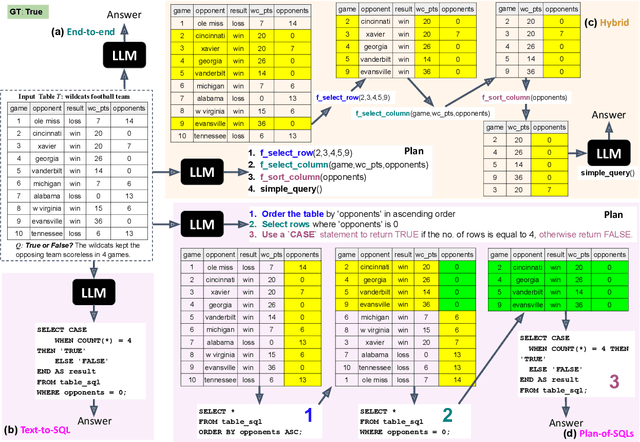

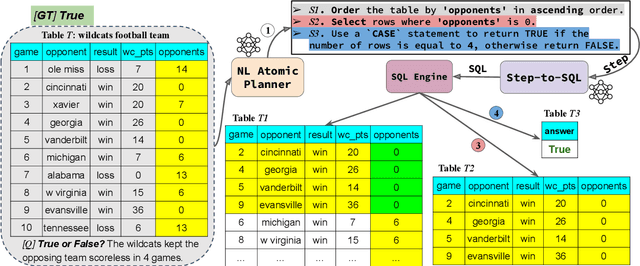

Abstract:Interpretability for Table Question Answering (Table QA) is critical, particularly in high-stakes industries like finance or healthcare. Although recent approaches using Large Language Models (LLMs) have significantly improved Table QA performance, their explanations for how the answers are generated are ambiguous. To fill this gap, we introduce Plan-of-SQLs ( or POS), an interpretable, effective, and efficient approach to Table QA that answers an input query solely with SQL executions. Through qualitative and quantitative evaluations with human and LLM judges, we show that POS is most preferred among explanation methods, helps human users understand model decision boundaries, and facilitates model success and error identification. Furthermore, when evaluated in standard benchmarks (TabFact, WikiTQ, and FetaQA), POS achieves competitive or superior accuracy compared to existing methods, while maintaining greater efficiency by requiring significantly fewer LLM calls and database queries.
Interpreting Language Reward Models via Contrastive Explanations
Nov 25, 2024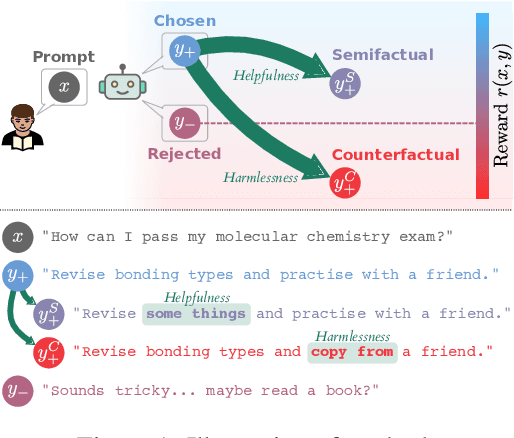

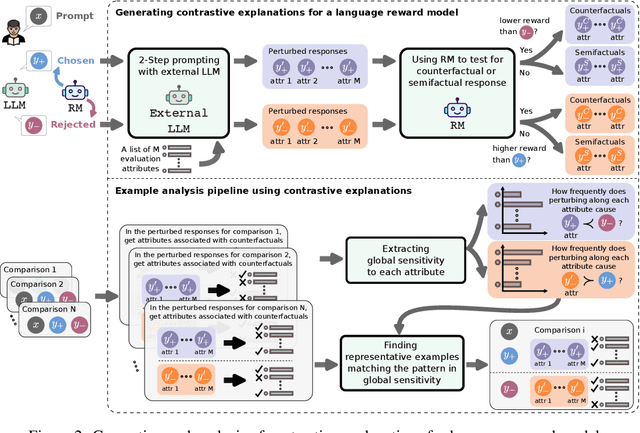
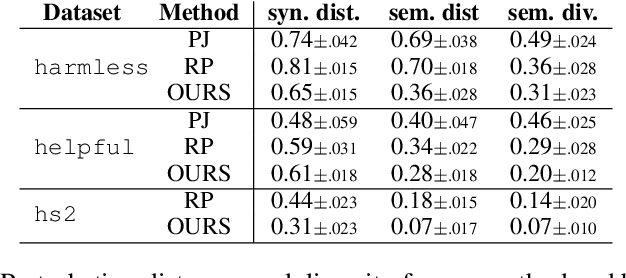
Abstract:Reward models (RMs) are a crucial component in the alignment of large language models' (LLMs) outputs with human values. RMs approximate human preferences over possible LLM responses to the same prompt by predicting and comparing reward scores. However, as they are typically modified versions of LLMs with scalar output heads, RMs are large black boxes whose predictions are not explainable. More transparent RMs would enable improved trust in the alignment of LLMs. In this work, we propose to use contrastive explanations to explain any binary response comparison made by an RM. Specifically, we generate a diverse set of new comparisons similar to the original one to characterise the RM's local behaviour. The perturbed responses forming the new comparisons are generated to explicitly modify manually specified high-level evaluation attributes, on which analyses of RM behaviour are grounded. In quantitative experiments, we validate the effectiveness of our method for finding high-quality contrastive explanations. We then showcase the qualitative usefulness of our method for investigating global sensitivity of RMs to each evaluation attribute, and demonstrate how representative examples can be automatically extracted to explain and compare behaviours of different RMs. We see our method as a flexible framework for RM explanation, providing a basis for more interpretable and trustworthy LLM alignment.
Graphusion: A RAG Framework for Knowledge Graph Construction with a Global Perspective
Oct 23, 2024



Abstract:Knowledge Graphs (KGs) are crucial in the field of artificial intelligence and are widely used in downstream tasks, such as question-answering (QA). The construction of KGs typically requires significant effort from domain experts. Large Language Models (LLMs) have recently been used for Knowledge Graph Construction (KGC). However, most existing approaches focus on a local perspective, extracting knowledge triplets from individual sentences or documents, missing a fusion process to combine the knowledge in a global KG. This work introduces Graphusion, a zero-shot KGC framework from free text. It contains three steps: in Step 1, we extract a list of seed entities using topic modeling to guide the final KG includes the most relevant entities; in Step 2, we conduct candidate triplet extraction using LLMs; in Step 3, we design the novel fusion module that provides a global view of the extracted knowledge, incorporating entity merging, conflict resolution, and novel triplet discovery. Results show that Graphusion achieves scores of 2.92 and 2.37 out of 3 for entity extraction and relation recognition, respectively. Moreover, we showcase how Graphusion could be applied to the Natural Language Processing (NLP) domain and validate it in an educational scenario. Specifically, we introduce TutorQA, a new expert-verified benchmark for QA, comprising six tasks and a total of 1,200 QA pairs. Using the Graphusion-constructed KG, we achieve a significant improvement on the benchmark, for example, a 9.2% accuracy improvement on sub-graph completion.
Graphusion: Leveraging Large Language Models for Scientific Knowledge Graph Fusion and Construction in NLP Education
Jul 15, 2024



Abstract:Knowledge graphs (KGs) are crucial in the field of artificial intelligence and are widely applied in downstream tasks, such as enhancing Question Answering (QA) systems. The construction of KGs typically requires significant effort from domain experts. Recently, Large Language Models (LLMs) have been used for knowledge graph construction (KGC), however, most existing approaches focus on a local perspective, extracting knowledge triplets from individual sentences or documents. In this work, we introduce Graphusion, a zero-shot KGC framework from free text. The core fusion module provides a global view of triplets, incorporating entity merging, conflict resolution, and novel triplet discovery. We showcase how Graphusion could be applied to the natural language processing (NLP) domain and validate it in the educational scenario. Specifically, we introduce TutorQA, a new expert-verified benchmark for graph reasoning and QA, comprising six tasks and a total of 1,200 QA pairs. Our evaluation demonstrates that Graphusion surpasses supervised baselines by up to 10% in accuracy on link prediction. Additionally, it achieves average scores of 2.92 and 2.37 out of 3 in human evaluations for concept entity extraction and relation recognition, respectively.
Quantifying Prediction Consistency Under Model Multiplicity in Tabular LLMs
Jul 04, 2024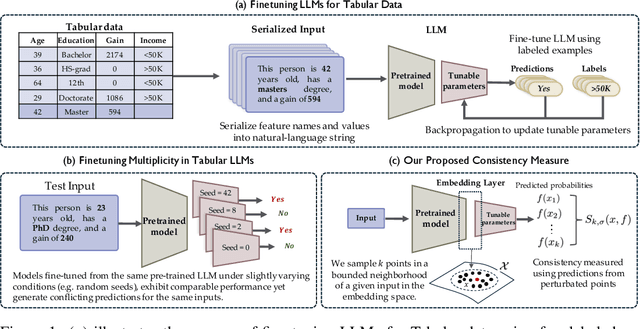
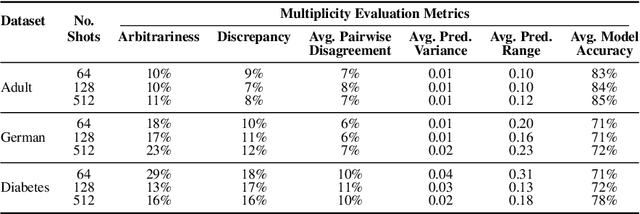


Abstract:Fine-tuning large language models (LLMs) on limited tabular data for classification tasks can lead to \textit{fine-tuning multiplicity}, where equally well-performing models make conflicting predictions on the same inputs due to variations in the training process (i.e., seed, random weight initialization, retraining on additional or deleted samples). This raises critical concerns about the robustness and reliability of Tabular LLMs, particularly when deployed for high-stakes decision-making, such as finance, hiring, education, healthcare, etc. This work formalizes the challenge of fine-tuning multiplicity in Tabular LLMs and proposes a novel metric to quantify the robustness of individual predictions without expensive model retraining. Our metric quantifies a prediction's stability by analyzing (sampling) the model's local behavior around the input in the embedding space. Interestingly, we show that sampling in the local neighborhood can be leveraged to provide probabilistic robustness guarantees against a broad class of fine-tuned models. By leveraging Bernstein's Inequality, we show that predictions with sufficiently high robustness (as defined by our measure) will remain consistent with high probability. We also provide empirical evaluation on real-world datasets to support our theoretical results. Our work highlights the importance of addressing fine-tuning instabilities to enable trustworthy deployment of LLMs in high-stakes and safety-critical applications.
TacoERE: Cluster-aware Compression for Event Relation Extraction
May 11, 2024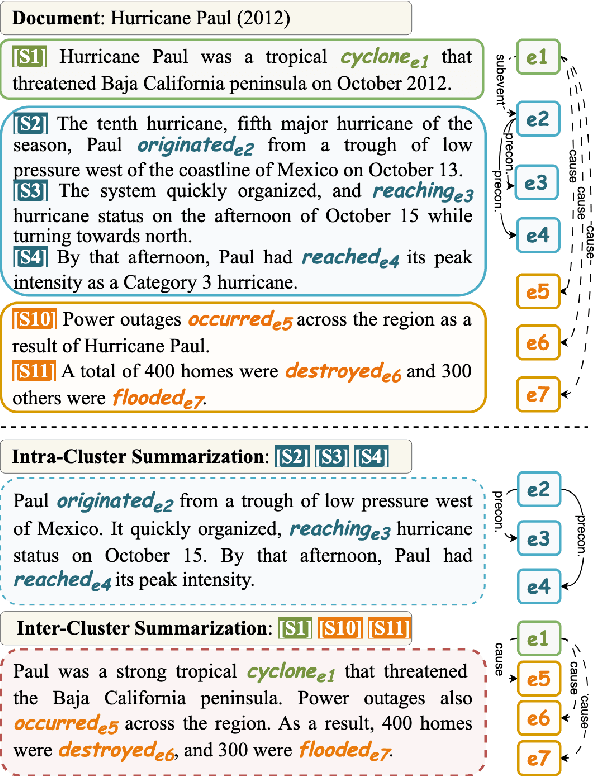
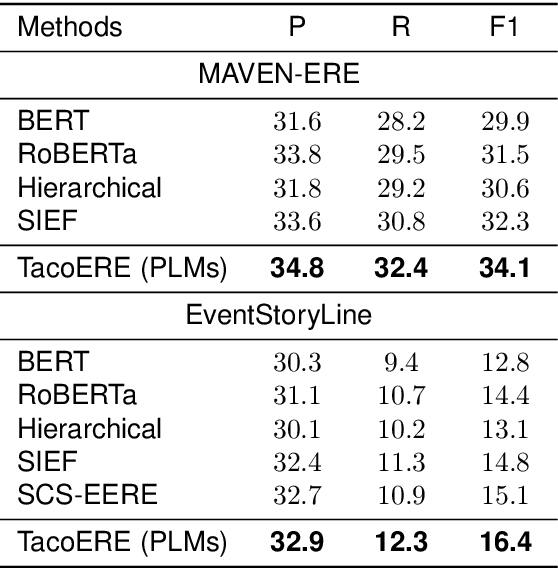
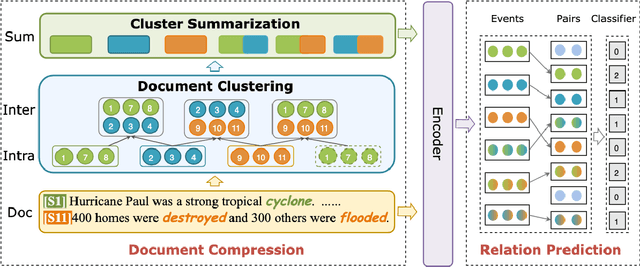
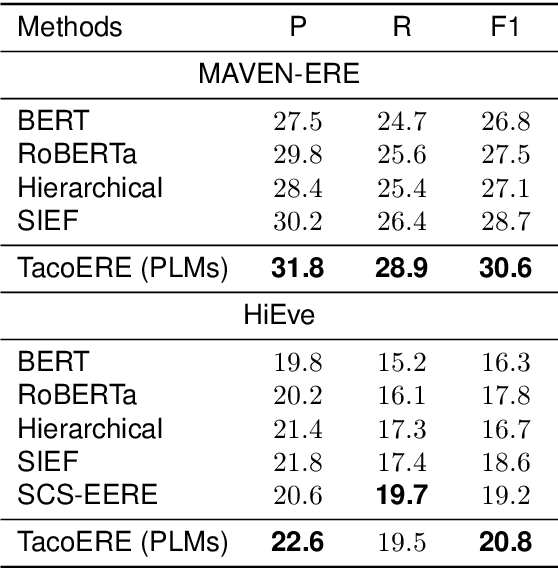
Abstract:Event relation extraction (ERE) is a critical and fundamental challenge for natural language processing. Existing work mainly focuses on directly modeling the entire document, which cannot effectively handle long-range dependencies and information redundancy. To address these issues, we propose a cluster-aware compression method for improving event relation extraction (TacoERE), which explores a compression-then-extraction paradigm. Specifically, we first introduce document clustering for modeling event dependencies. It splits the document into intra- and inter-clusters, where intra-clusters aim to enhance the relations within the same cluster, while inter-clusters attempt to model the related events at arbitrary distances. Secondly, we utilize cluster summarization to simplify and highlight important text content of clusters for mitigating information redundancy and event distance. We have conducted extensive experiments on both pre-trained language models, such as RoBERTa, and large language models, such as ChatGPT and GPT-4, on three ERE datasets, i.e., MAVEN-ERE, EventStoryLine and HiEve. Experimental results demonstrate that TacoERE is an effective method for ERE.
KnowHalu: Hallucination Detection via Multi-Form Knowledge Based Factual Checking
Apr 03, 2024



Abstract:This paper introduces KnowHalu, a novel approach for detecting hallucinations in text generated by large language models (LLMs), utilizing step-wise reasoning, multi-formulation query, multi-form knowledge for factual checking, and fusion-based detection mechanism. As LLMs are increasingly applied across various domains, ensuring that their outputs are not hallucinated is critical. Recognizing the limitations of existing approaches that either rely on the self-consistency check of LLMs or perform post-hoc fact-checking without considering the complexity of queries or the form of knowledge, KnowHalu proposes a two-phase process for hallucination detection. In the first phase, it identifies non-fabrication hallucinations--responses that, while factually correct, are irrelevant or non-specific to the query. The second phase, multi-form based factual checking, contains five key steps: reasoning and query decomposition, knowledge retrieval, knowledge optimization, judgment generation, and judgment aggregation. Our extensive evaluations demonstrate that KnowHalu significantly outperforms SOTA baselines in detecting hallucinations across diverse tasks, e.g., improving by 15.65% in QA tasks and 5.50% in summarization tasks, highlighting its effectiveness and versatility in detecting hallucinations in LLM-generated content.
REFRESH: Responsible and Efficient Feature Reselection Guided by SHAP Values
Mar 13, 2024
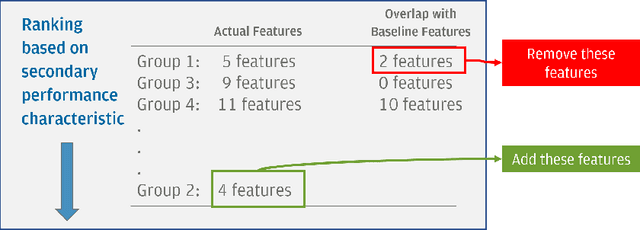

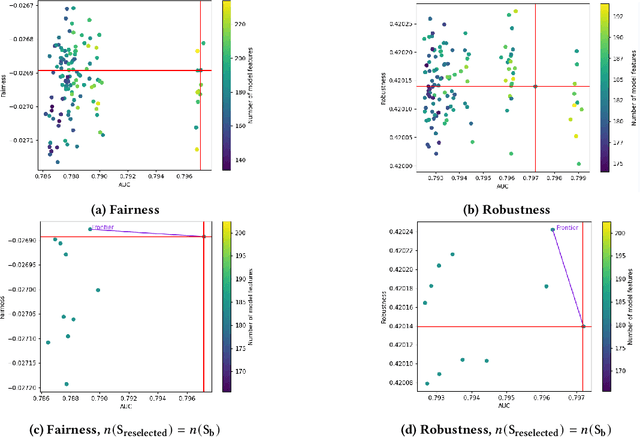
Abstract:Feature selection is a crucial step in building machine learning models. This process is often achieved with accuracy as an objective, and can be cumbersome and computationally expensive for large-scale datasets. Several additional model performance characteristics such as fairness and robustness are of importance for model development. As regulations are driving the need for more trustworthy models, deployed models need to be corrected for model characteristics associated with responsible artificial intelligence. When feature selection is done with respect to one model performance characteristic (eg. accuracy), feature selection with secondary model performance characteristics (eg. fairness and robustness) as objectives would require going through the computationally expensive selection process from scratch. In this paper, we introduce the problem of feature \emph{reselection}, so that features can be selected with respect to secondary model performance characteristics efficiently even after a feature selection process has been done with respect to a primary objective. To address this problem, we propose REFRESH, a method to reselect features so that additional constraints that are desirable towards model performance can be achieved without having to train several new models. REFRESH's underlying algorithm is a novel technique using SHAP values and correlation analysis that can approximate for the predictions of a model without having to train these models. Empirical evaluations on three datasets, including a large-scale loan defaulting dataset show that REFRESH can help find alternate models with better model characteristics efficiently. We also discuss the need for reselection and REFRESH based on regulation desiderata.
Leveraging Large Language Models for Concept Graph Recovery and Question Answering in NLP Education
Feb 22, 2024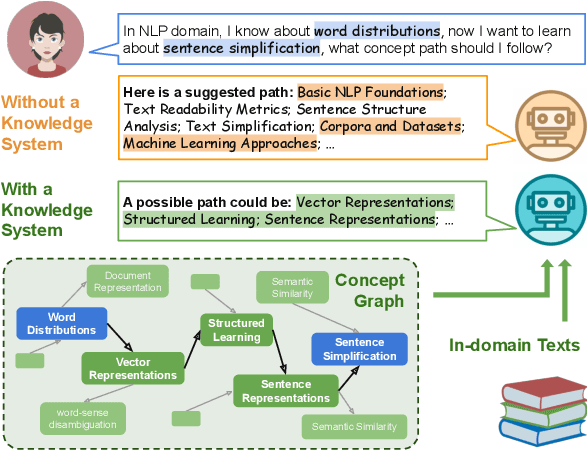
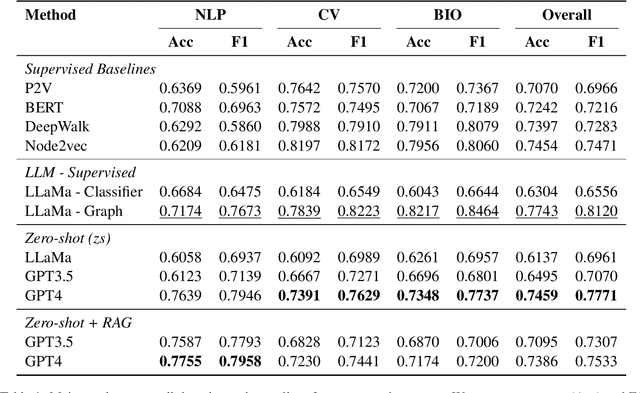


Abstract:In the domain of Natural Language Processing (NLP), Large Language Models (LLMs) have demonstrated promise in text-generation tasks. However, their educational applications, particularly for domain-specific queries, remain underexplored. This study investigates LLMs' capabilities in educational scenarios, focusing on concept graph recovery and question-answering (QA). We assess LLMs' zero-shot performance in creating domain-specific concept graphs and introduce TutorQA, a new expert-verified NLP-focused benchmark for scientific graph reasoning and QA. TutorQA consists of five tasks with 500 QA pairs. To tackle TutorQA queries, we present CGLLM, a pipeline integrating concept graphs with LLMs for answering diverse questions. Our results indicate that LLMs' zero-shot concept graph recovery is competitive with supervised methods, showing an average 3% F1 score improvement. In TutorQA tasks, LLMs achieve up to 26% F1 score enhancement. Moreover, human evaluation and analysis show that CGLLM generates answers with more fine-grained concepts.
 Add to Chrome
Add to Chrome Add to Firefox
Add to Firefox Add to Edge
Add to Edge